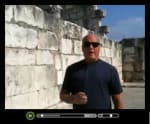Capernaum
Capernaum – New Testament Importance
Capernaum was a town on the western shore of the Sea of Galilee, inhabited from the Hasmonean era in about 150 B.C. to sometime in the Crusader era, possibly around the 11th century A.D. Thus, it contains New Testament and later remains, but was settled long after the end of the Old Testament writings. In addition to being mentioned in the New Testament, the town also appears in the writings of 1st century Jewish historian Josephus Flavius. The name comes from the Hebrew Kfar Nahum, meaning village of Nahum.
Capernaum – Jesus and His Disciples
The ancient fishing village of Capernaum is said to be the home of Peter, James, John, Andrew, and Matthew, and notable remains from the 1st century exist. An impressive 4th century A.D. synagogue, dated by thousands of coins found beneath the pavement and in many cases used as gravel for the mortar, still stands today. But, underneath the 4th century A.D. white limestone synagogue in Capernaum lies a 1st century A.D. black basalt synagogue, dated based on the pottery found on the floors, making it one of the oldest synagogues in the world. The black basalt walls are 4 feet thick, convincing archaeologists that this could not have been a private dwelling. The building is referenced by the 4th century A.D. pilgrim Egeria and mentioned in the gospels of Mark, Luke, and John. Only column fragments and the floor remain from the 1st century synagogue, but it is enough to identify it. The main hall of the synagogue measures 24.4 meters by 18.65 meters, and two inscriptions, one in Greek and the other in Aramaic, apparently commemorate those who helped construct the building. “They went into Capernaum; and immediately on the Sabbath He [Jesus] entered the synagogue and began to teach” (Mark 1:21). “These things He said in the synagogue as He taught in Capernaum” (John 6:59).
Capernaum – House of Peter
In Capernaum, an octagon shaped church was built in the 5th century A.D., during the Byzantine period. But, underneath this church were discovered remains of an even earlier church, built around a house that was originally built in the Late Hellenistic Period (specifically 2nd century B.C.) and changed into a house church in the late 1st century A.D. The church room, with walls measuring an extensive 7.5 meters, was the only room in the city with plaster floors and walls, and had a conspicuous absence of household ceramic remains, while many oil lamps have been discovered which would have been used for lighting. According to the excavators, Christian graffiti in Aramaic, Greek, Syriac, and Latin, mentioning both Lord Jesus Christ and Peter, was found on the walls and dated to the 2nd century A.D.
The house has an extremely early tradition as being the home of Peter, from at least the 4th century A.D. during the pilgrimage of Egeria, who wrote “And in Capernaum, what is more, the house of the prince of the apostles (Peter) has been turned into a church, leaving its original walls however quite unchanged.” The house is also dated to the 1st century A.D. on the basis of the composition—the same black basalt of the 1st century synagogue. However, the walls of the house were much thinner, and would have been covered by a thatch roof, like the roof described in Mark 2:4. “And when Jesus entered Capernaum, a centurion came to Him, imploring Him…When Jesus came into Peter’s home, He saw his mother-in-law lying sick in bed with a fever” (Matthew 8:5, 14). “And immediately after they came out of the synagogue, they came into the house of Simon and Andrew, with James and John” (Mark 1:29).
The passages in Matthew and Mark indicate not only that Peter’s house was in Capernaum, but that it was extremely close to the synagogue. The house site is just outside the entrance of the synagogue remains, 84 feet to the south, less than a minute walk away. One of the miracles of Jesus occurred here—the healing of the centurion’s servant (Matthew 8:5, Luke 7:1, Mark 2:1).
Capernaum – Fishing on Galilee
As many of the disciples were described as fishermen, and Capernaum was described as a fishing village, so the excavations have also revealed. Fish hooks and weights for fish nets, along with other lower class household items such as basic pottery, weaving implements, and grain millers were discovered. In 1986, nearby the village, a fishing boat measuring 8 meters long and dated to the 1st century A.D. was uncovered at the bottom of the Sea of Galilee during an extremely low water year. It had been preserved for 2,000 years by being encased in mud. This boat provides an example of the type of boat used by Jesus and his disciples. The original boat and also a reconstruction of a 1st century A.D. Galilee fishing boat can be viewed today in a museum in Galilee.
Compliments of Titus and our friends at Drive Thru History. Copyright 2010 – All rights reserved in the original.
What is your response?

